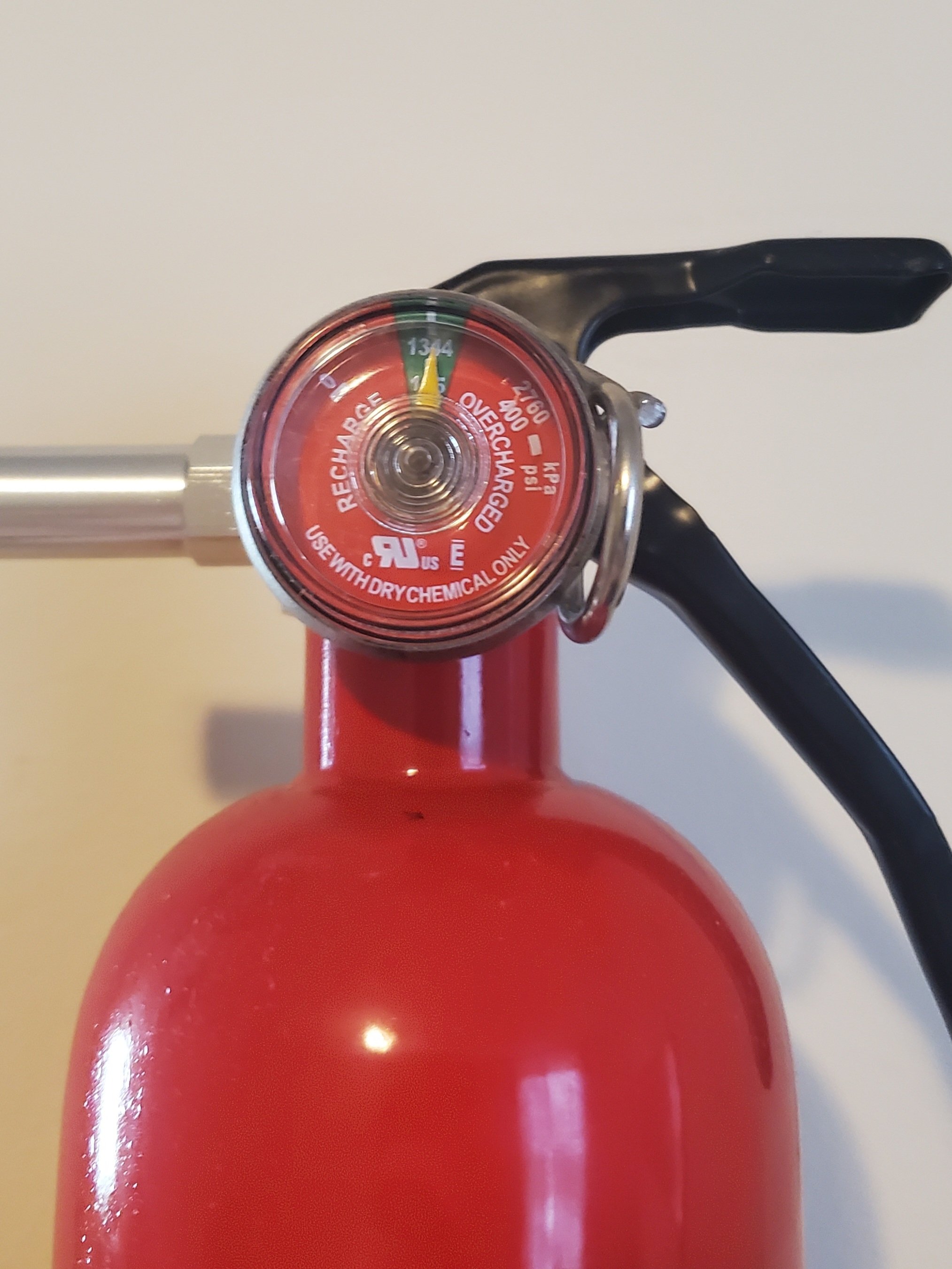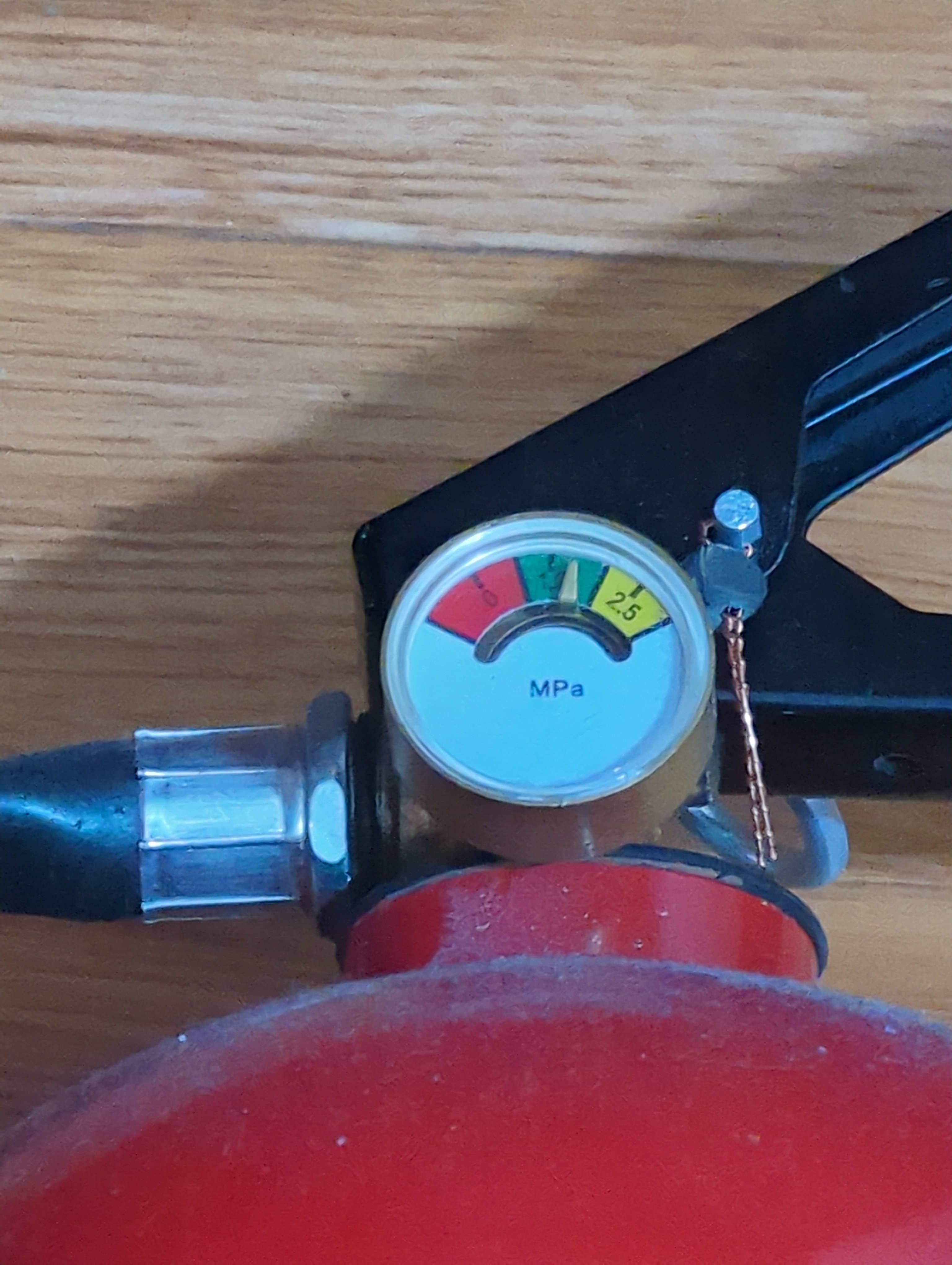
Piggybacking on this PSA to remind everyone;
- Attack the base of the fire, where the fuel source is. You need to break the fire triangle to stop the reaction, and drowning out oxygen is the easiest way.
- Each rated pound of fire extinguisher yields approximately one second of use. They go quickly when you’re fighting any fire, and even small fires fight back. 5lb is the minimum imo, look at any commercial setting where OSHA applies and it’s big 10-20lb tanks generally.
- Trainers advise to blow the whole extinguisher even if flames aren’t visible to prevent auto-ignition.
- You really, really want a hose on any extinguisher. Invert the extinguisher to get under a car/cabinet/low obstacle and the extinguisher is useless as the pressurized gas escapes, leaving behind the powder/foam/water that actually stops fire.
I have 3. 2 are still pressurized. One was used last night.
A note to everyone…do your welding before you paint and undercoat, or at least wait for it to dry fully first.
Hope it all turned out ok! You’re posting so clearly you survived
Everything is fine. I was welding in the outer rocker when it ignited. It was a brief flash and then it went out. I only used the fire extinguisher because I saw smoke coming from the seatbelt hole near the top of the door. I figured better safe than sorry. Of course now the inside of the rocker that I can’t get to anymore is covered in white powder, but at least it’s kinda fireproof now.
Maybe I am just projecting here, but I believe the average Lemmy user to be too much of a nerd to be welding in their free time. Is it possible to be both Bonehead?
You’re projecting. I weld because I’m a nerd. This job is just helping out a buddy, but before that I was welding a new mount for my trailer hitch snow plow that I built a few years ago. And this summer I want to build a remote control lawnmower which is going to involve a lot of welding, plus some code to reprogram the hoverboards that I bought for that project. The real challenge there will be adding basic intelligence with a Raspberry Pi so that it will mow the lawn itself. But that’s a few years away, since I still need to build it first. And that starts with welding the frame.
It’s not really possible to be both, since one is merely a tool that satisfies the needs of the other. Nerd always takes precedence…
I have four fire extinguishers:
- One in the kitchen
- One in the basement
- One in my office (where I do stuff like soldering and 3D-printing)
- One mounted to the roll bar of my Miata (I ought to get some for my other cars, but haven’t gotten around to making mounting brackets yet)
However, I never would’ve thought to check them (or turn them upside down to “fluff” them) without this post, so thanks!
Followed by: do you have a functional fire extinguisher in your kitchen and can you reach it immediately?
Stove top fires are usually easy, just put a lid on whatever to put them out, but there’s always going to be someone who panics and dumps water on a grease fire.
Not too immediately. Take 3 steps back/towards the nearest exit, that’s where you want the extinguisher. Not right next to the stove that’s going to be on fire when you need to get to the extinguisher.
Keep in mind that a standard ABC extinguisher isn’t rated for grease fryers. If it’s just the fat needed to sautee something you’re good, but for an actual deep frying fire you want something in class K.
I’m a professional fire performer, so I have four :P
(Admittedly two need refilling)
Absolutely it is one of these products that you probably never need. But when you do you are so happy you had it standing around.
I do routine inspections once a year when I do my fire alarm testing so every time I switch to daylight saving time.
Just caused an oil fire last week and fortunately it was working. I’ve since replaced also.
Fire blankets are good to have as well
Do they go bad even if they are still pressurized? I’m thinking they are nearly 20 years old now…
Yup. And you’re supposed to have a professional inspect them annually. You’re supposed to inspect them every month.
Good question.
Yes the dry powder type which is most common, can go “bad” usually from excessive moisture in the pressurization gas. This causes the powder to clump and no longer come out.
This can be prevented by inverting the extinguisher a few times a year to make sure the powder is still “fluid” and to break up any clumped up powder.
deleted by creator
And synced smoke alarms
Same. Also, they are both smoke and heat alarms so they also trigger for smokeless fires. They are also linked into my home automation system, if triggered every light in the house will turn on to maximum brightness. It will also send an alert to my phone.
deleted by creator
Wouldn’t know, never used it. I tend to stay away from anything written in python as much as I can.
deleted by creator
Some languages are much more difficult to write reliable and stable code in, especially for larger codebases. Python is one of those. I’m not saying it can’t be done, but that’s despite the language being used, not thanks to it.
My home runs on OpenHAB, which is written in Java and built on top of OSGi.
When I set up my home automation (which was years ago) I looked into the technical aspects of the different options and OpenHAB had by far the most solid architecture.
deleted by creator
To my experience, writing reliable code is more about the coding strategy than anything else, the language used doesn’t even make the list. And I’ve developed with pascal back in the day.
Language makes a lot of difference in my experience. For example: a good type system can eliminate entire classes of mistakes. In Swift for example there are optional types, Non-optional types can never be
niland for optional types you have to explicitly deal with the possibility of a variable beingnil. Boom, null-pointer error are a thing of the past, enforced by the compiler. One less thing to worry about.
why?
It’s very difficult to write and maintain any significant amount of code in a ducktyped language. I don’t trust python code to be reliable or stable. It’s a nice toy language for academic projects but in no way suitable for production use. I certainly won’t have it controlling the things in my home that should just work, like the lights.
There is plenty of production code written and maintained in Python outside of academia, as well as Perl, PHP and others. You’re presenting an opinion as fact.
I’m not saying it can’t be done, only that it’s not a good idea.
what’s is ducktyped
In most programming languages data has a type. You can think of it as the ‘shape’ of the data. For example: you have an ‘integer’ type which can contain whole numbers, a ‘floating point’ type which can contain fractional numbers, a ‘string’ type which can contain text, etc.
These simple types are called ‘primitive’ types, they are built into the language itself.
Usually, you can also define your own types, which are made up of the primitive types, for example: you can have a ‘car’ type:
class Car { float maximumSpeed; int numberOfPassengers; String brand; String model; }Meaning any piece of data of type ‘Car’ has a maximum speed, number of passengers, brand an model.
Now languages like Java have so called static typing. You declare something to be a car, and the compiler knows that a car has these properties. This is used in a lot of places. Variables have types, parameters passed to a function have types. The return values of functions have types, etc. Static typing means you always know exactly what type of data you are dealing with.
Ducktyping is the exact opposite. The term comes from ‘if it walks like a duck and quacks like a duck, it’s probably a duck’. In a ducktyped language you don’t declare what type something is, you just use the data as if you know what type it is, and if it’s the correct type, it works. If it’s not, things might break.
In a statically typed language it is impossible to use the wrong type, this is enforced by the compiler. In a ducktyped language this is impossible, as the types are not declared. So if a function expects a ‘Car’ as a parameter, and you pass in a ‘Horse’ instead, in Java you would get an error when trying to compile this code. In Python it would just run it. This may be fine. A horse may also have a maximumSpeed and if you try to read that it would work. But when you try to access something a Horse doesn’t have, like the ‘brand’ property, things go tits up.
The main problem with this is that you only see this if you happen to run that specific bit of code in that specific situation. It may never happen during testing. Worse, if you change anything in ‘Car’ you don’t necessarily catch all the problems this causes. Say you rename ‘numberOfPassengers’ to ‘passengerCount’, in Java any code that still tried to access ‘numberOfPassengers’ would fail to compile, you’d immediately get an error. In Python you wouldn’t spot this problem at all until it’s too late.
The advantage of ducktyping is that it’s less verbose, you can whip something together quickly without having to think too much about the types. For a small simple program this is perfect, but the larger your codebase gets the harder it becomes to manage this. You can’t oversee the whole codebase anymore, mistakes happen and the compiler won’t catch them.
You can mitigate it a little, for example by writing lots of automated tests, but you really shouldn’t have to. A static type system prevents a lot of dumb mistakes from being made.
deleted by creator
One 2.5 in each bedroom, a 5 in the kitchen and a 5 in the rest of the downstairs, a 10 and a 20 in the garage, and then a 20 CO2 for my servers.
I have one in my car, I check it every 6 months. I was trained to do full inspections and repairs at my last job. I only have a fire blanket in the house though.
Yup, one for every floor!

Yes and yes
I have one and pressure is OK (at least if the gauge isn’t stuck). Is there anything else that you can check yourself instead of having it professionally inspected once a year? Does anyone know what they inspect?
Fire related: If you have smoke detectors there should be a button on it to check the battery.
Not fire related: You can check if your home first aid kit needs to be restocked. Sometimes you might take out some bandages and forget to replace them.







